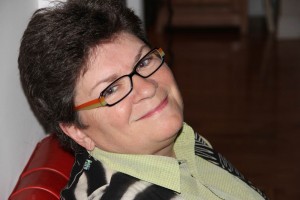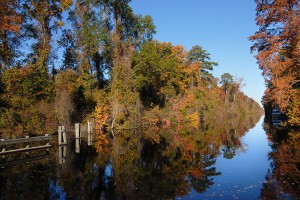Interview by RHETT REGISTER

Georgann Eubanks. Photo by Donna Campbell.
Georgann Eubanks is author of all three books in the North Carolina Literary Trails series. She is a writer, teacher and consultant to nonprofit groups. Director of the Table Rock Writers Workshop, she was a founder of the North Carolina Writer’s Network and is past chair of the North Carolina Humanities Council. Her latest project is the North Carolina River Writers — a series of public interviews with North Carolina writers that look at how North Carolina’s rivers have inspired stories, novels, plays and poems. Here, Eubanks chats about her travels in eastern North Carolina, what influence place has on writers and how she thinks readers can best use her guidebooks.
How should readers use this book?
You don’t have to start at the beginning. People have told me that they will look up a place they know they’re going to visit and read in advance about what’s there. If they have time to plan ahead, they might check out a book or two that is mentioned on a tour — something they can read while there. I think a lot of people have used the tours vicariously — to experience the sites in their imaginations while sitting comfortably in an armchair. But the books are meant to serve as guides to things both seen and unseen, like a map. If you want to delve deeper, go to the library and keep reading from an excerpted author whose work interests you.
How does reading about a place add to a visit?
Writers tend to be people who have a knack for putting into words what they are seeing, feeling, smelling and tasting. Good writing recreates experience. The excerpts from writers along the Literary Trails are intended to help you see more, look harder and appreciate the history of a place. And there are places in North Carolina where the history is almost palpable. Walking through the Elizabethan Gardens in Manteo — even though they are a recent development — you can look out across the water where the first colonists came in and marvel at their hardship. Or you can step right into the Dismal Swamp and feel the forbidding quality of the landscape there — the cypress knees, the mosquitoes. Suddenly it is possible to imagine the terror of the enslaved people who chose to run into those woods and hide rather than remain in bondage. Those are some forbidding, thick and dangerous woods.

Recent research suggests as many as 50,000 escaped slaves lived in the Dismal Swamp. Courtesy N.C. Division of Parks and Recreation.
So there is an environmental aspect to writing, and that is the reason for the focus on place. As Eudora Welty said, “You can’t take a story and move it to a different place and have it be the same story.” It’s just not the same. Place shapes people and shapes a story. It is really important in fiction, poetry and nonfiction. Sometimes the authors in Literary Trails help us know how it used to be and what’s changed in a landscape — sometimes for the better, sometimes not. What is most powerful is when the writers recreate their own native habitat in words and make it real to us on the page.
In your exploration of the coast, did you encounter a coastal voice or style of writing?
I think writing about the coast is as varied as in the rest of the state. We start out with the earliest writing by the explorers, which is very flowery, of its era and sometimes daunting to read. That is the other thing about this project. We’re talking about 400-plus years of writing, because the earliest explorers and settlements go back that far. The journals of John Lawson writing about New Bern, or William Bartram writing about the western part of the state, take us back to a very different style of prose than contemporary North Carolina writers use — except for Charles Frazier, who was clearly inspired by Bartram in the style of prose he adopted for Cold Mountain.
I think the coast has prompted certain themes that may be more prevalent in the east than elsewhere. We have beach romances and the terrors of World War II … you know the fact that we actually had enemy combatants right off the coast is significant. We also have the era of the Revolution. Inglis Fletcher and James Boyd both write about Edenton during the Colonial Period. The first decades of English settlement in North Carolina and the suppression of the native peoples provide a significant story that has yet, perhaps, to be fully told.
Eastern North Carolina has got it all — from submarines and sea captains to the glories of fishing and the dangers of violent hurricanes. There’s a lot of drama associated with eastern North Carolina.
I think we’ve had — and this is just talking off the top of my head — a lot more genre fiction that’s been inspired by the coast than probably any other part of the state.
Can you suggest some coastal North Carolina writers?
Nicholas Sparks has done more single-handedly for eastern North Carolina than most popular fiction writers. He’s made some lesser-known towns better recognized by name dropping in his books. I like David Payne myself, who lives part time in Hillsborough. Then there are other popular writers who have come here and become completely captivated by our pristine beaches. For example, Anne Rivers Siddons from Georgia and Homer Hickam, who was born in West Virginia, have written about our coast. Everybody loves those lighthouses, don’t they? We’ve got it all!
This book ends with the Lost Colony. How does that mystery factor into the region’s writing?
I was just at a writer’s conference last week up in the mountains of Ashe County, and the theme of the conference was secrets. Every writer that spoke there could easily address the issue of secrets, no matter what genre they were writing. Because, in a way, writing is a process of trying to understand a secret, a mystery or reveal more than meets the eye about a subject. The story of the Lost Colony is one of those mysteries that has always been a fascination.
In practical terms, the Paul Green play about the Lost Colony has been running successfully on the coast for more than 75 years. Still, every now and then, up pops some new historical detail that might be another clue to resolving the mystery of the colony’s disappearance. All kinds of people have written about it, most recently Marjorie Hudson who lives in Chatham County. I suppose we could argue that the story ultimately has created a long-running appetite among North Carolina readers and writers for mysteries. And we certainly have an abundance of mystery writers working in the state today. For the Literary Trails series, I decided from the start that I would end the books at the beginning, at the Lost Colony, because it is such a fundamental myth for North Carolina.
The amount of research and interviews you must have done for this book is staggering. You must have knocked on a lot of doors. Can you share an anecdote from your research?
There were places where I did go and knock on people’s doors or go to a local library and somebody would offer to help me find something — a grave, an historical marker, a particular house. In the east, however, once you get past Bath, there’re not many doors to knock on. There are long stretches of flat road only interrupted by water.
I really love Lake Mattamuskeet. When I took my brother on a trip down there, he said, “This looks just like Holland.” And we came to find out that a lot of the settlers in the area were Dutch and had tried to drain the lake and plant crops there just as the Dutch had done in their own country. They were drawn to that area because it looked so familiar. For me, being at Lake Mattamuskeet when the tundra swans and snow geese start coming in is pretty amazing. The lake is only a swan’s neck deep. I also love looking for the golden eagles that sometimes land next to the man-made catfish ponds along Highway 64 as you are headed from Columbia to Plymouth. For me, going to eastern North Carolina is really about connecting to the natural world.
This interview was published in the Holiday 2013 issue of Coastwatch.
For contact information and reprint requests, visit ncseagrant.ncsu.edu/coastwatch/contact/.
Visit the University of North Carolina Press to purchase a copy of the book.
